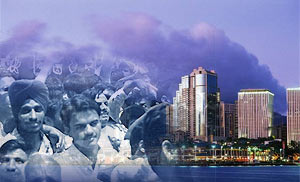The Rediff US Special/ Aseem Chhabra


Fuelled by the demand for hi-tech visa workers as well as a growing number of immigrants sponsoring their families, the Asian Indian population in the United States has doubled in the last 10 years, according to data released on Tuesday by the Census Bureau and analyzed by the Asian American Federation Census Information Centre.
Based on the count of the 2000 Census, there are 1.7 million people in the US who identify themselves as Asian Indians or Indian Americans -- first- and second-generation immigrants or those whose ancestors migrated to the US from India.
"It is a little early to say, but the economy definitely has something to do with this increase," Parag Khandhar, a policy associate and census coordinator at AAFCIC said. "One obvious factor for the growth in the Indian American community is the importing of the hi-tech workers."
According to an estimate provided by the Immigration Support Network, a lobby group that works in the interests of H1-B workers, last year there were approximately 400,000 Asian Indian hi-tech visa holders in the US. Most of them had arrived in the past few years to run what was then a booming new (Internet-based) economy.
"If you look at places like New Jersey and New York City, you are seeing that more Indian Americans specifically are getting involved in politics and thinking about representation issues," Khandhar said, adding that these people were inspired by the dramatic increase in the numbers of Asian Indians. Currently there are five South Asians, including three Indian Americans, running for the New York City Council.
Although Chinese Americans constitute the largest Asian sub-group in the US (2.4 million people and 24 per cent of the total Asian population), followed by Filipinos (1.9 million or 18 per cent), Asian Indians had the largest and unprecedented growth rate in the 10 years since the last census.
The Asian Indian growth of 106 per cent from 1990 to 2000 was way ahead of other Asian American communities, Khandhar added. This growth was followed by that of the Vietnamese American community (83 per cent growth rate and 1.2 million in population) and the Other Asian categories (65 per cent growth rate and 1.3 million in population).
The 2000 census forms gave people the option of selecting one of the following Asian ethnicities -- Asian Indian, Chinese, Filipino, Vietnamese, Korean and Japanese.
For the first time people also had the option of printing an ethnicity of their choice, including Sri Lankan, Pakistani, Bangladeshi and Nepali. The data released on Tuesday only captures the six large ethnic categories. Census data related to smaller ethnic groups (including those labelled as Other Asian) and detailed breakdown by states will be released in the weeks and months to come.
The decline in the Japanese population can be attributed to low migration from Japan to the US. Khandhar pointed out that post-industrial societies such as Japan and Italy are currently facing a decline in their population growth.
Khandhar said the number of 1.7 million Asian Indians may be underrepresented, since the Census Bureau did not make an all-out effort to educate the ethnic communities about the importance of filling out census forms. Besides English, the forms were available in five other languages -- Spanish, Chinese, Korean, Vietnamese and Tagalog.
The bureau provided instructions in 49 different languages (including Bengali, Hindi, Tibetan and Urdu), but people did not know where to get them, Khandhar added.
All the census advertisements for the South Asian community were aimed at people from India. In addition, the advertisements were only in English. Later South Asian community groups -- especially on the East Coast -- did step in with posters in Gujarati, Urdu, Bengali and Punjabi.
"Communities that did not have English proficiency, and communities where folks were afraid, including undocumented workers, they may not show up in these numbers," Khandhar said. "Even with H1-B visa workers and people on other temporary visas, they might say 'Oh I am not a permanent resident here' and they might not have responded to the census forms."
The census is an official headcount of people living in the United States on April 1, 2000. This should have included American citizens, permanent residents, those who were living on a large assortment of visas -- F1, H1-B, H4, G4, etc -- and even undocumented illegal immigrants.
Another issue that the current numbers do not capture is that of mixed race. In 1990 a person whose one parent was Indian and the other a white Caucasian may have chosen to identify himself or herself as Asian Indian. In 2000, the Census Bureau gave people the choice of checking more than one race.
"The data now is more accurate, but we don't know which option people selected," Khandhar said. "The way the Census Bureau has told us is we had to give a range. So this [1.7 million Asian Indians] is the low end of the range. It might be higher."
With the unprecedented growth in the Asian American population, local and state-level governments will face challenges to meet the needs of this community.
"We will be advocating for a fair share throughout the [New York] city and nationally people will be doing the same, but at the same time the Indian American community needs to recognize that as its population grows and changes, we have significant needs that have to be met and we have to up the bar for ourselves," Khandhar said.
"It's fine for people to donate wherever they donate, but also to recognize that we need to establish a history of giving within our community."
Back to top
Tell us what you think of this feature